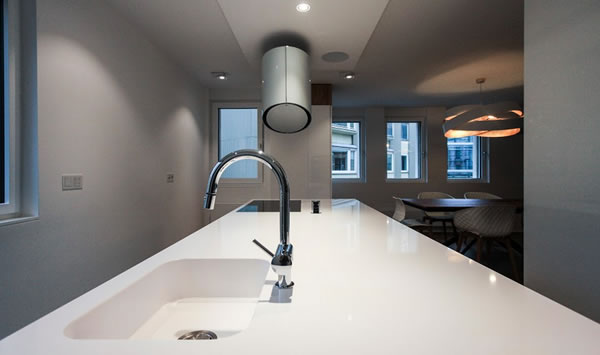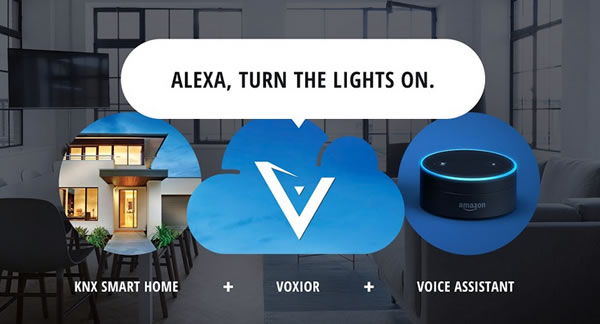 By Dejan Bukovnik, Voxior.
By Dejan Bukovnik, Voxior.
The revolution of intuitive hands-free computing is already here. According to Mark Warburton of Ivory Egg, this is “the first time people have communicated with computers and machines using our own natural interface instead of a machine interface such as a keyboard, mouse or screen.”
Leading the way in this revolution are our voices. They are becoming a medium for interaction with devices in our surroundings. And this revolution is driving a new industry for home voice assistant devices – projected to deliver close to 100 million units by 2020, and more than 150 million by 2022, according to Evercore ISI. With stakes in this market by players such as Amazon, Google, Microsoft, Samsung and Apple, interaction with the digital world, including our homes, is bound to shift fast and become more intuitive, more natural.

In a further step yet towards the naturalisation of our technological environment, modern domestic living is set to undergo a radical change with the popularisation of the connected home, one that enables the integration of multiple devices, services and apps in real time. The smart home allows different approaches to home automation, entertainment, communication, security, etc., but the focus is mostly on two areas – user comfort and efficient resource usage.
Having to carry a smartphone or tablet around the home, or having to find a wall controller, then finding the correct app or page, in order to turn the lights on and off, could hardly be described as a seamless, convenient experience. A voice-controlled personal assistant, on the other hand, is far more intuitive.

Indeed a growing demand for smart home solutions is expected to grow rapidly. According to BI Intelligence estimates, the demand for smart home solutions will push shipments of connected home devices to a compound annual growth rate of 67% over the 2014–2019 period, but many of these do not support voice interfaces.
That creates enormous business opportunities.
The principles of voice technology
Modern voice assistants are activated with a ‘wake’ word said to a microphone – which can be switched off by the way – or by pressing a button that starts the recording of your voice. This recording of what is said is then sent to the cloud to be processed. Based on what the computer has already learnt from a large global speech recognition database and from your personal utterance and pronunciation, it produces a number of accurate guesses as to what has been said and the probability of finding the right match is calculated. This is then converted into a command. In the case of Alexa for instance, these commands are sent to a particular ’skill’ and executed.

If Alexa doesn’t execute your command to turn on the lights for example, you may have stumbled upon one of the challenges of the technology – most obvious one being too much background noise. The isolation of background noise is being tackled by equipping devices with a number of quality microphones.
The computer’s ability to understand voice, however, has seen tremendous improvements, measured in word error rates (WER) and brought in by advancements in fields such as artificial intelligence and voice recognition algorithms. In just a bit more than two decades, we have arrived at a 4.9% WER from as high as 43% – nearly on par with humans.
Progress so far
This improvement in accuracy is making voice assistants more appealing to users, and is creating a completely new ecosystem with many integrated third-party services. The current leader in building this ecosystem is definitely Amazon’s Alexa, which Reuters writes has a 70.6% market share for voice-controlled speaker-based assistants. The runner-up, Alphabet Inc’s Google Home, is trailing with a 23.8% market share.
Amazon’s head start is mostly a consequence of beating everyone to market for two years, and also by having the Alexa Skills Kit which allows developers to build and publish Skills for Alexa. This toolkit for building third-party solutions is generating many different services in finance, productivity, food and drink, fitness, travel, entertainment and, naturally, the smart home; and the numbers are growing incredibly fast.
Engadget reports a tenfold increase from a few thousand to ten of thousand skills from May 2016 to February 2017, and then an additional 50% to 15,000 in the period from February to June.

The second first for Amazon is the availability of Development Kits for Building Products with Alexa, which allows manufacturers to integrate Alexa into their devices. Automotive industry giants such as Volkswagen, Ford and BMW have already announced integration of Alexa with their products.
CNBC reports that in 2020, Amazon alone will sell 60 million devices and reach 500 million active customers globally, assuming a 40% adoption rate in the U.S. and 25% internationally. With Google, Apple, Microsoft, Samsung and others following with their own ecosystems and solutions, we can conclude that voice assistants are coming into our lives and homes, and making an appearance everywhere else, quickly, and in large numbers. Many businesses and industries will have to adapt to that and evolve their products for the new interface – voice.

Connected buildings
So, now that we’ve covered the interfaces, what about the market for the second ingredient of the modern smart home? Connected devices such as sensors, lights, monitors, cameras, energy meters, energy equipment, smart appliances, safety and security systems and the communication protocols between them. What’s happening here?
In terms of communication protocols between connected devices the lead in North America goes to proprietary protocols, while KNX is at the forefront in China and Europe, with ZigBee, Z-Wave, Wi-Fi Bluetooth and others following.
The value of the global market for Smart Home and Light Commercial solutions is forecasted to rise by 20% to $15.8 billion in 2017, with stand-alone products being the segment with the largest growth – 27%, according to a BSRIA study published by the KNX Association. The same study forecasts that by 2021 the total global market will almost double to US$29.8 billion.
Integration with KNX
When integrating a voice assistant into a KNX building, system integrators have to consider a number of things:
• Does the integration require additional hardware.
• Position of microphones covering various scenarios.
• Naming of commands to enable a natural voice interface.
• Can existing programming be used to reduce the amount of integration work.
• Maintenance cost.
As Mark Warburton says, it’s difficult to turn a consumer-led technology into a real tool to control KNX homes because integrating them into a fully-programmed KNX home requires a lot of work. And you end up needing to charge your customer many multiples of the cost of Alexa, just to get it to do something which it appears should be possible straight out of the box. The integration should be as simple as possible and should allow remote installation and remote management.

As a starting point for a given project, the systems integrator should consider which specific functions are going to be controlled by voice and which are not. It is also important to pose the question whether the current naming of devices used for visualisation make sense when being used for voice commands, or whether it is best to modify them.
An additional question that arises is what new possibilities are actually enabled for scene configurations because of the presence of voice control. Examples could be taking the garbage out, hands full, calling the kids to dinner by blinking the lights in their rooms, or setting the living room to movie scene. In any case, there is room for systems integrators to use their expertise and deliver additional services to help their customers fall in love with their smart environment even more.
A future controlled by voice
All of the current indicators strongly point to a voice-controlled future, and with more and more smart devices inhabiting buildings everywhere, the importance of standardised communication protocols and all-inclusive hubs with the ability to connect and control all the devices of a modern home, from lights to loudspeakers, and all the voice assistants, from Alexa to Google Home, will become even more important.
Because the two crucial ingredients of standardisation and all-inclusivity, have already been deeply rooted in KNX’s DNA for more than 20 years, it is in an ideal position to help bridge the gap between the connected home and the intuitive interface.
By taking this step, the KNX world will ensure future growth of the standard, broaden its appeal to new customers, be able to offer new services to existing customers, add new possibilities to the smart home portfolio and make smart homes even smarter. There is a huge opportunity here. Let’s grab it!
Dejan Bukovnik is the Co-founder of Voxior, creator of the Voxior cloud service that links voice assistants such as Amazon Alexa with a KNX gateway.











